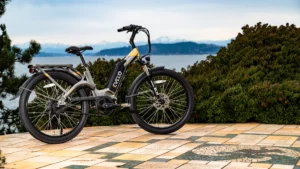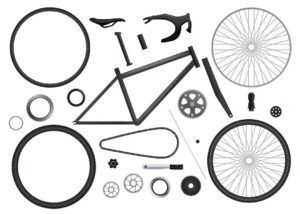자전거의 중추적인 부품으로서, 전방 서스펜션 포크는 고르지 않은 지형의 충격을 완화하는 데 도움이 됩니다., 충격을 흡수하다, 견인력을 유지하고, 이를 통해 라이더의 편안함을 향상시킵니다., 제어, 그리고 전반적인 성능. 바위길을 헤쳐나가든, 루트가 있는 경로 탐색, 또는 단순히 도시의 장애물을 순항하는 것, 안정적인 프론트 서스펜션 포크가 있으면 라이딩 품질과 즐거움이 크게 달라질 수 있습니다.. 확실히, 다양한 유형의 프론트 서스펜션 포크를 이해하면 라이딩 경험에 큰 영향을 미칠 수 있습니다. 이 가이드는 11 프론트 서스펜션 포크의 종류, 귀하의 자전거 타기 요구 사항에 맞는 정보에 기초한 선택을 할 수 있는 지식을 제공합니다..
서스펜션 포크란??
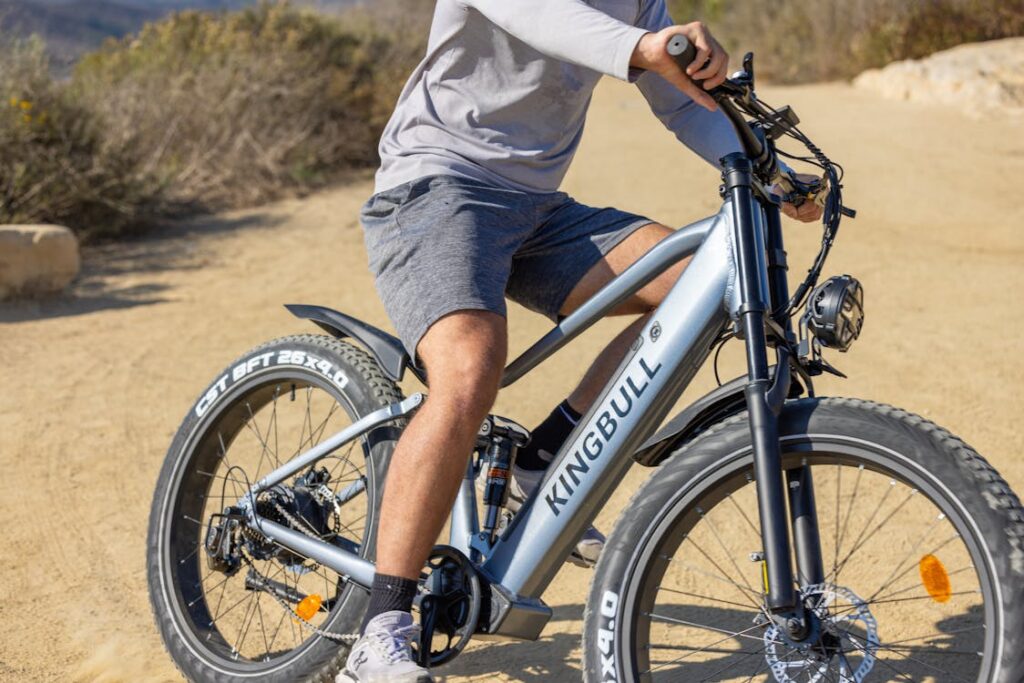
서스펜션 포크, 등의 재료로 제작 알류미늄, 탄소섬유, 또는 강철, 스프링을 수용하는 텔레스코픽 튜브 시스템으로 구성됩니다., 댐퍼, 및 기타 메커니즘. 이러한 구성 요소는 시너지 효과를 발휘하여 충격을 흡수합니다., 견인력을 강화하다, 거친 지형에서 보다 원활한 탐색을 촉진합니다.. 이 경이로운 공학 기술은 사이클리스트가 고르지 않은 표면을 더욱 편안하게 다룰 수 있도록 해줍니다., 안정, 그리고 자신감, 짜릿하고 통제된 라이딩 경험을 보장합니다..
다양한 디자인으로 나오네요, 각각은 독특한 기능을 제공합니다, 장점, 그리고 한계. 전통적인 코일 스프링 포크부터 혁신적인 에어 스프링 변형까지, 수력학적 경이로움에서 기계적 경이로움까지, 자전거 포크 제조업체 다양한 선호도와 라이딩 스타일에 맞춰. 자전거 서스펜션 포크 유형의 미묘한 차이를 이해하면 자전거 운전자가 자신의 특정 요구 사항과 선호도에 맞는 충분한 정보를 바탕으로 결정을 내릴 수 있습니다..
에어 스프링 서스펜션 포크
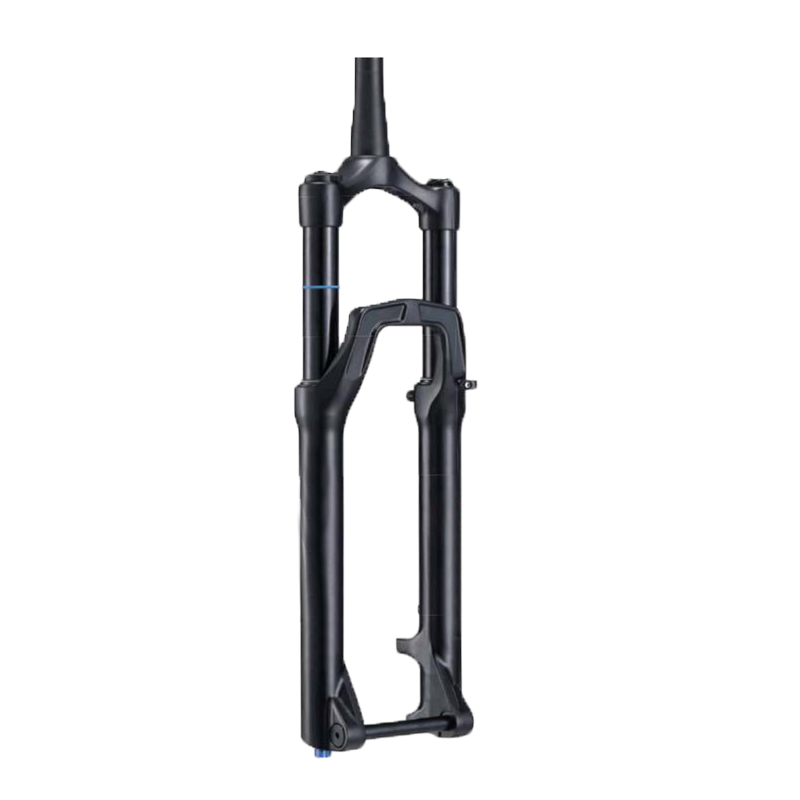
에어 스프링 서스펜션 포크는 압축 공기 챔버를 활용하여 라이더 선호도와 지형 조건에 맞춰 조정 가능한 서스펜션 성능을 제공합니다.. 이 포크는 가벼운 구조로 인해 선호됩니다., 조정 가능성, 그리고 반응성, 다양한 선호도에 맞춰 맞춤형 라이딩 경험 제공.
장단점
프로:
- 경량 구조로 전체 자전거 무게 최소화, 민첩성과 기동성 향상.
- 조정 가능한 공기압을 통해 라이더는 다양한 지형과 라이딩 스타일에 맞게 서스펜션 특성을 미세 조정할 수 있습니다..
- 반응성이 뛰어난 성능은 공격적인 라이딩 중에 뛰어난 작은 범프 컴플라이언스와 지지력을 제공합니다..
단점:
- 최적의 성능을 달성하려면 초기 설정 및 조정에 약간의 전문 지식이 필요할 수 있습니다..
- 에어 씰과 챔버는 파편과 충격으로 인해 손상되기 쉽습니다., 주기적인 유지관리가 필요한.
- 코일 스프링 포크에 비해 초기 비용이 높음, 예산에 민감한 자전거 이용자를 잠재적으로 억제할 수 있음.
에어포크의 일반적인 관리
에어 포크에는 일반적으로 윤활 및 댐핑 목적으로 오일이 필요합니다.. 에어 챔버가 스프링 메커니즘을 제공하면서, 씰과 같은 내부 부품을 윤활하려면 오일이 필수적입니다., 부싱, 시간이 지나도 부드럽고 일관된 성능을 보장하는 댐핑 회로.
유압 서스펜션 포크
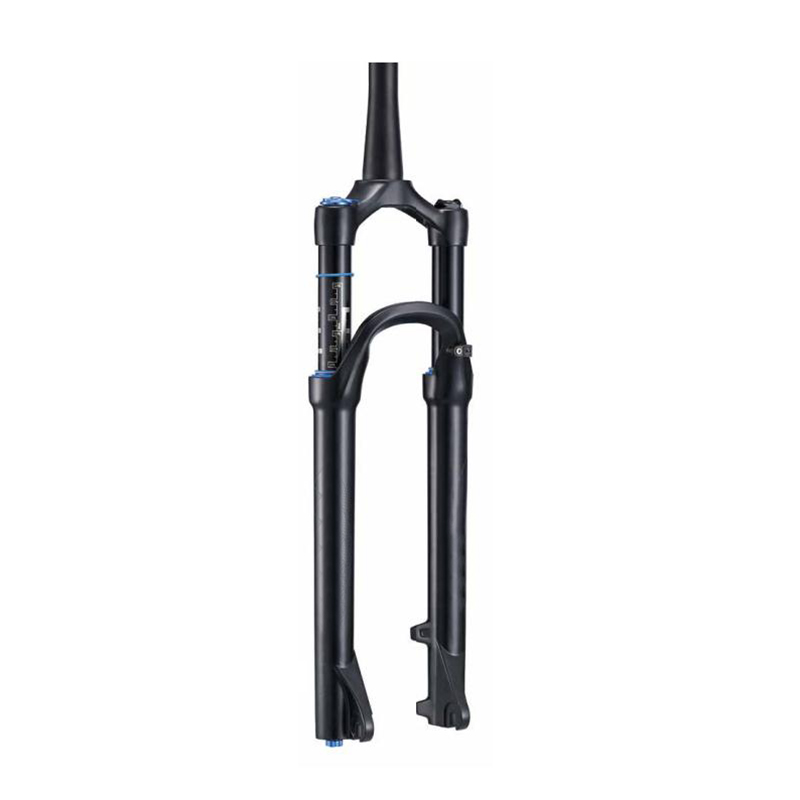
유압식 서스펜션 포크는 유체 기반 댐핑 시스템을 활용하여 압축 및 리바운드 댐핑을 조절합니다., 라이더 선호도에 맞춰 정밀한 제어 및 댐핑 특성 제공. 이 포크는 부드럽고 일관된 성능으로 유명합니다., 최적의 서스펜션 성능을 원하는 안목 있는 라이더들 사이에서 인기를 얻습니다..
장단점
프로:
- 뛰어난 댐핑 제어 기능으로 다양한 지형에서 편안하고 제어된 승차감을 제공합니다..
- 유압 시스템은 광범위한 조정 옵션을 제공합니다., 라이더가 원하는 대로 서스펜션 동작을 미세 조정할 수 있음.
- 다양한 온도와 조건에서도 일관된 성능, 어떤 라이딩 환경에서도 안정적인 성능 보장.
단점:
- 다른 서스펜션 포크 유형에 비해 초기 비용이 높음, 예산에 민감한 자전거 이용자의 접근성을 잠재적으로 제한함.
- 복잡한 내부 구성 요소에는 유지 관리 및 서비스를 위한 특수 도구와 전문 지식이 필요할 수 있습니다..
- 시간이 지남에 따라 유체 누출 및 씰 마모에 취약함, 주기적인 점검과 유지보수가 필요한.
테이퍼드 스티어러 튜브 포크
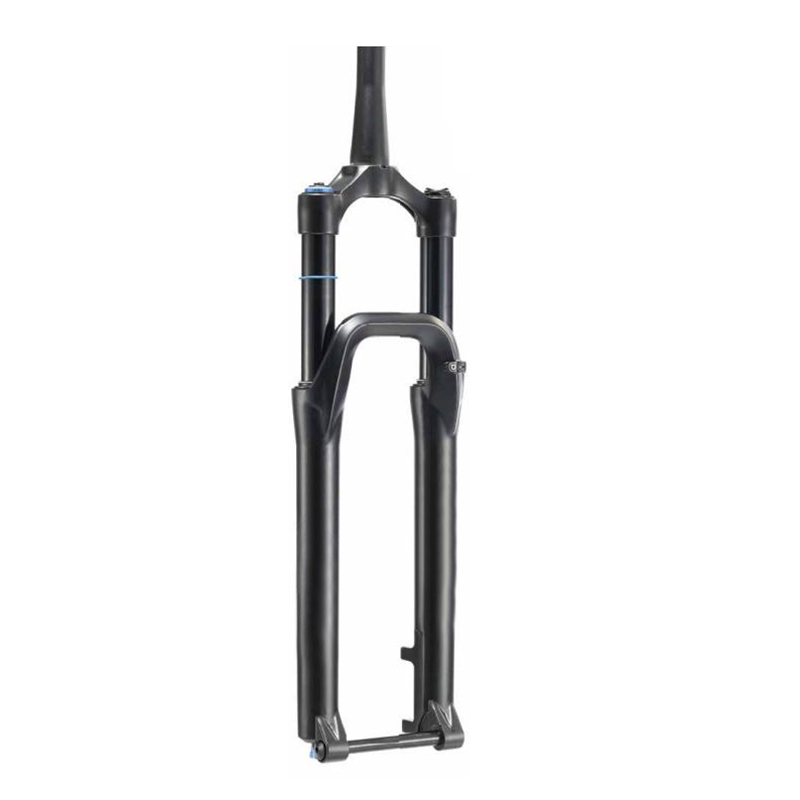
테이퍼드 스티어러 튜브 포크는 스티어러 튜브 직경이 더 큰 치수에서 더 작은 치수로 전환되는 테이퍼형 디자인을 특징으로 합니다., 강화된 강성을 제공, 힘, 최신 프레임 디자인 및 헤드 튜브 구성과의 호환성.
장단점
프로:
- 직선형 조향 튜브 포크에 비해 강성과 조향 정밀도가 향상되었습니다., 특히 무거운 짐을 싣거나 공격적인 라이딩을 할 때.
- 최신 프레임 지오메트리 및 헤드 튜브 표준과의 향상된 호환성, 다양한 자전거 모델과 분야에 걸쳐 광범위한 채택을 보장합니다..
- 기존 직선형 스티어러 튜브 포크에 비해 무게 감소, 전반적인 자전거 민첩성과 기동성을 최적화합니다..
단점:
- 구형 프레임 디자인 및 헤드셋 표준과의 제한된 호환성, 잠재적으로 개조를 위해 프레임 수정 또는 어댑터 솔루션이 필요할 수 있습니다..
- 직선형 조향 튜브 포크에 비해 비용이 높음, 특히 첨단 소재와 제조 기술을 갖춘 프리미엄 포크 모델에서.
- 애프터마켓 스템 및 헤드셋 구성 요소와의 잠재적인 호환성 문제는 자전거 조립 및 맞춤화 중에 신중하게 고려해야 합니다..
테이퍼드 스티어러 튜브 포크에 대한 호환성 고려 사항
테이퍼드 스티어러 튜브 포크를 선택할 때, 라이더는 자전거 프레임의 헤드 튜브 치수 및 헤드셋 사양과의 호환성을 확인해야 합니다.. 또한, 애프터마켓 스템 및 헤드셋 구성 요소와의 호환성을 확인하면 호환성 문제를 방지하고 기존 자전거 설정과의 원활한 통합을 보장할 수 있습니다..
직선 조향 튜브 포크
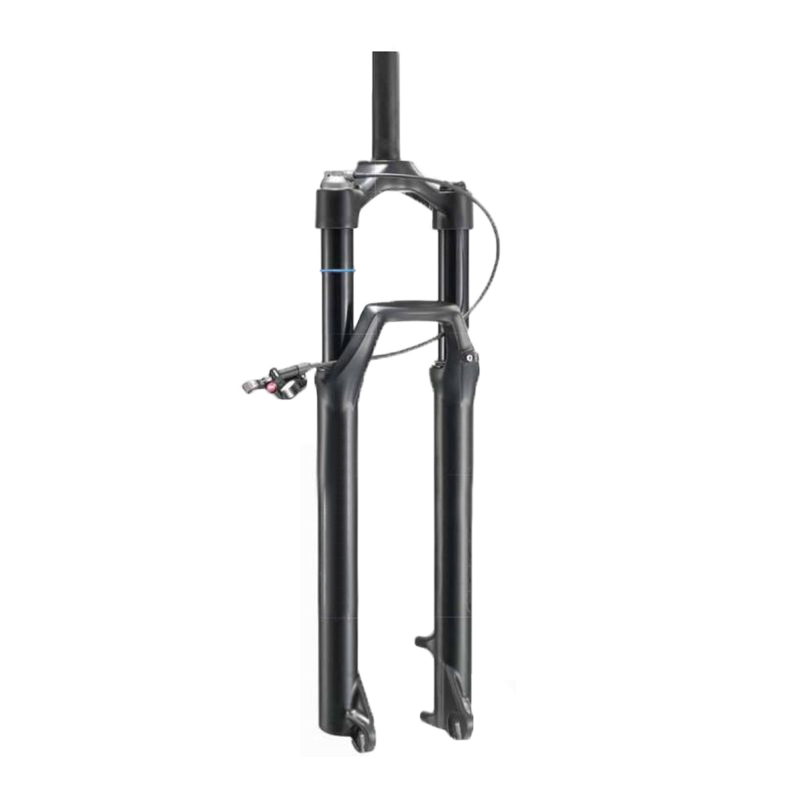
직선형 조향 튜브 포크는 균일한 직경의 조향 튜브 디자인을 특징으로 합니다., 단순함을 제공, 다재, 다양한 프레임 디자인 및 헤드셋 표준과의 호환성. 현대 고성능 자전거에서는 덜 일반적이지만, 직선 조향 튜브 포크는 특정 용도 및 예산 친화적인 자전거 모델에서 여전히 인기가 있습니다..
장단점
프로:
- 다양한 프레임 형상 및 헤드셋 표준과의 다양한 호환성, 다양한 자전거 모델과 분야에 걸쳐 광범위한 채택을 보장합니다..
- 테이퍼드 스티어러 튜브 포크에 비해 조립 및 유지보수가 간편함, 잠재적인 실패 지점 및 호환성 문제 감소.
- 예산에 민감한 사이클리스트나 고급 시스템의 복잡성 없이 기본적인 서스펜션 솔루션을 원하는 사람들을 위한 비용 효율적인 옵션.
단점:
- 테이퍼드 스티어러 튜브 포크에 비해 강성과 조향 정밀도 감소, 특히 무거운 짐을 싣거나 공격적인 라이딩을 할 때.
- 고성능 직선 조향 튜브 포크 옵션의 제한된 가용성, 고급 서스펜션 기능과 기술을 원하는 라이더의 선택이 잠재적으로 제한적임.
- 테이퍼드 스티어러 튜브 포크에 비해 잠재적인 무게 감소, 특히 강철 또는 합금 조향 튜브가 장착된 모델의 경우.
직선 조향 튜브 포크의 인기 있는 용도
고성능 자전거 디자인의 인기가 감소하고 있음에도 불구하고, 직선 조향 튜브 포크는 도시 통근과 같은 특정 용도에서 여전히 널리 사용됩니다., 레크리에이션 승마, 그리고 입문자용 산악자전거.
유압 서스펜션 포크에 대한 유지 관리 팁
유압식 서스펜션 포크의 최적의 성능과 수명을 유지하려면, 씰 정기 검사, 유체 수준, 댐핑 설정은 필수입니다. 또한, 제조업체가 권장하는 서비스 간격을 따르고 고품질 서스펜션 유체를 활용하면 유압 구성품의 수명을 연장하고 시간이 지나도 일관된 성능을 보장할 수 있습니다..
잠금 서스펜션 포크
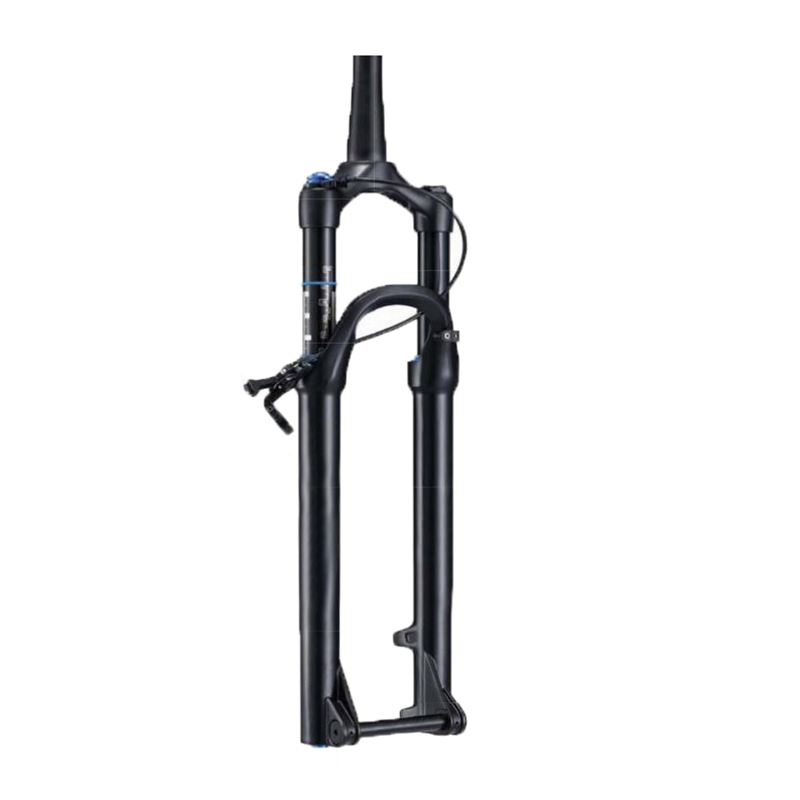
잠금 서스펜션 포크는 라이더가 서스펜션 이동을 일시적으로 비활성화할 수 있는 기계식 또는 유압식 메커니즘을 갖추고 있습니다., 효과적으로 “잠금” 포크를 견고한 플랫폼으로 변환. 이 기능은 서스펜션 움직임이 불필요한 트레일의 부드러운 구간이나 오르막 구간에서 페달링 효율성을 유지하는 데 특히 유용합니다..
장단점
프로:
- 평탄한 지형이나 오르막 지형에서 향상된 페달링 효율성과 동력 전달, 잠금 장치가 제공하는 견고한 플랫폼 덕분에.
- 서스펜션 보빙 및 무브먼트를 통한 에너지 손실을 최소화하여 등반 성능 및 견인력 향상.
- 다양한 프레임 디자인 및 라이딩 스타일과의 다양한 호환성으로 다양한 자전거 모델 및 분야에 걸쳐 널리 채택될 수 있습니다..
단점:
- 서스펜션이 잠겨 있으면 거칠거나 기술적인 지형에서 편안함과 제어력이 감소합니다., 견인력과 핸들링이 잠재적으로 손상될 수 있음.
- 비잠금 포크에 비해 복잡성 증가, 잠재적으로 더 높은 유지 관리 요구 사항과 실패 지점으로 이어질 수 있습니다..
- 애프터마켓 스템 및 핸들바 구성품과의 호환성 문제에 취약함, 자전거 조립 및 맞춤 제작 시 신중한 고려가 필요함.
잠금 기능을 효과적으로 활용하는 방법
잠금 기능을 효과적으로 활용하려면, 라이더는 서스펜션 움직임이 불필요하거나 페달링 효율성에 해로운 트레일의 매끄럽거나 오르막 구간을 만날 때 잠금 장치를 작동해야 합니다.. 거꾸로, 하강하거나 거친 지형을 주행할 때 편안함을 극대화하기 위해 잠금 장치를 해제해야 합니다., 견인, 서스펜션 포크가 제공하는 제어. 다양한 잠금 설정을 실험하고 페달링 효율성과 승차감에 미치는 영향을 관찰하면 라이더가 다양한 트레일 조건과 선호도에 맞게 서스펜션 설정을 최적화하는 데 도움이 될 수 있습니다..
코일 스프링 서스펜션 포크
코일 스프링 서스펜션 포크는 코일형 금속 스프링을 활용하여 주행 중 충격을 흡수하고 쿠셔닝을 제공합니다.. 이 포크는 내구성이 좋기로 유명합니다, 신뢰할 수 있음, 다양한 지형에서 일관된 성능. 코일 스프링 포크의 압축 및 반동 특성은 개별 라이더 선호도에 맞게 조정될 수 있는 경우가 많습니다..
장단점
프로:
- 견고한 구조로 수명과 신뢰성 보장.
- 일반적으로 다른 서스펜션 포크 유형에 비해 가격이 저렴합니다..
- 최소한의 유지 관리 요구 사항, 번거롭지 않은 성능을 원하는 라이더에게 이상적입니다..
단점:
- 일반적으로 에어 스프링 제품보다 무겁습니다., 잠재적으로 전체 자전거 무게에 영향을 미칠 수 있음.
- 고급 서스펜션 시스템에 비해 조정 가능성이 제한됨.
- 경험할 수 있음 “코일 바인드” 극심한 압축을 받고 있는, 서스펜션 효과 감소로 이어짐.
코일 스프링 포크의 최고의 용도
코일 스프링 서스펜션 포크는 내구성이 뛰어난 응용 분야에서 탁월합니다., 간단, 그리고 경제성이 가장 중요합니다. 입문용 산악자전거에 적합합니다., 통근용 자전거, 보다 정교한 시스템의 복잡성 없이 안정적인 서스펜션 성능을 원하는 레크리에이션 라이더.
기계식 서스펜션 포크
기계식 서스펜션 포크, 엘라스토머 포크라고도 함, 라이딩 중 쿠셔닝과 충격 흡수 기능을 제공하기 위해 탄성 소재를 활용합니다.. 현대 자전거 디자인에서는 덜 일반적이지만, 기계식 포크는 단순성을 제공합니다., 신뢰할 수 있음, 낮은 유지 보수 요구 사항, 캐주얼 라이더와 도시 통근자에게 적합합니다..
장단점
프로:
- 간단하고 안정적인 설계로 유지 관리 요구 사항과 잠재적인 오류 지점을 최소화합니다..
- 경량 구조로 자전거 민첩성과 기동성이 향상되었습니다., 특히 도시 환경에서.
- 초급 수준의 사이클리스트 또는 고급 시스템의 복잡성 없이 기본적인 서스펜션 솔루션을 원하는 사람들을 위한 비용 효율적인 옵션.
단점:
- 다른 서스펜션 포크 유형에 비해 제한된 조정성, 잠재적으로 승차감과 성능이 저하될 수 있습니다..
- 엘라스토머 재료가 마모됨에 따라 시간이 지남에 따라 성능 저하 및 손실이 발생할 수 있습니다..
- 일반적으로 유압식 또는 공기 스프링 포크에 비해 고주파 충격 감쇠 효과가 떨어집니다..
기계식 포크와 다른 유형의 포크 사이의 성능 차이
기계식 서스펜션 포크는 단순성과 신뢰성을 제공합니다., 동일한 수준의 조정 가능성을 제공하지 않을 수 있습니다., 플러시 천, 더욱 발전된 서스펜션 시스템으로서의 성능. 최대한의 제어력을 원하는 라이더, 조정 가능성, 편안함을 위해 유압식 또는 공기 스프링 포크가 제공하는 우수한 감쇠 특성과 조정 가능성을 선호할 수 있습니다..
거꾸로 된 서스펜션 포크
거꾸로 된 서스펜션 포크, 역 포크라고도 알려져 있음, 하부 지지대가 더 두껍고 크라운에 부착되는 디자인이 특징, 상부 튜브는 더 얇아지고 휠 액슬에 연결됩니다.. 이 독특한 구성은 강성 측면에서 여러 가지 장점을 제공합니다., 체중 분포, 그리고 반응성, 특히 공격적인 오프로드 라이딩 시나리오에서.
장단점
프로:
- 기존 서스펜션 포크에 비해 강성과 강성이 향상되었습니다., 조향 정밀도 및 제어 향상.
- 스프링 하중량이 낮아 서스펜션 반응성과 견인력이 향상됩니다., 특히 고속 하강 및 기술 기동 중에.
- 무거운 하중이나 급제동 시 굴곡 및 비틀림 비틀림 감소, 더 예측 가능한 핸들링과 안정성을 제공합니다..
단점:
- 기존 서스펜션 포크 설계에 비해 제조 복잡성 및 비용이 더 높음, 고급 자전거 모델에 대한 접근성이 잠재적으로 제한됨.
- 특정 프레임 디자인 및 휠 크기와의 제한된 호환성, 자전거 선택 및 맞춤화 시 신중한 고려가 필요함.
- 노출된 지지대 때문에 충격 및 잔해로 인한 손상에 대한 민감성 증가, 세심한 유지 관리 및 보호 조치가 필요함.
거꾸로 된 포크가 탁월한 응용 분야
거꾸로 된 서스펜션 포크는 내리막 산악자전거와 같은 분야에서 선호됩니다., 무임승차, 그리고 엔듀로 경주, 최대 강성, 제어, 그리고 대응력이 가장 중요합니다. 공격적인 오프로드 환경에서 타협할 수 없는 성능을 원하는 라이더는 거꾸로 된 포크 디자인이 제공하는 뛰어난 기능의 이점을 누릴 수 있습니다..
단일 크라운 서스펜션 포크
단일 크라운 서스펜션 포크는 상부 지지대와 하부 지지대를 연결하는 단일 포크 크라운을 특징으로 합니다., 무게 절감의 균형을 제공, 단단함, 다양한 라이딩 분야에 적합한 다용성. 이 포크는 다재다능한 성능과 다양한 프레임 디자인 및 휠 크기와의 호환성으로 인해 산악 자전거 타는 사람들에게 특히 인기가 있습니다..
장단점
프로:
- 기존 서스펜션 포크에 비해 강성과 강성이 향상되었습니다., 조향 정밀도 및 제어 향상.
- 스프링 하중량이 낮아 서스펜션 반응성과 견인력이 향상됩니다., 특히 고속 하강 및 기술 기동 중에.
- 무거운 하중이나 급제동 시 굴곡 및 비틀림 비틀림 감소, 더 예측 가능한 핸들링과 안정성을 제공합니다..
단점:
- 기존 서스펜션 포크 설계에 비해 제조 복잡성 및 비용이 더 높음, 고급 자전거 모델에 대한 접근성이 잠재적으로 제한됨.
- 특정 프레임 디자인 및 휠 크기와의 제한된 호환성, 자전거 선택 및 맞춤화 시 신중한 고려가 필요함.
- 노출된 지지대 때문에 충격 및 잔해로 인한 손상에 대한 민감성 증가, 세심한 유지 관리 및 보호 조치가 필요함.
싱글 크라운 포크가 산악 자전거 타는 사람들에게 인기가 있는 이유
단일 크라운 서스펜션 포크는 무게 사이의 조화로운 균형을 유지합니다., 단단함, 그리고 성능, 크로스컨트리를 위한 다양한 옵션을 제공합니다., 자취, 그리고 올마운틴 라이딩. 최신 프레임 지오메트리 및 휠 크기와의 호환성 덕분에 다양한 지형과 라이딩 스타일에 적합한 서스펜션 솔루션을 찾는 산악 자전거 라이더들 사이에서 널리 채택될 수 있습니다..
더블 크라운 서스펜션 포크
더블 크라운 서스펜션 포크, 듀얼 크라운 포크라고도 함, 상부 및 하부 지지대를 연결하는 이중 포크 크라운이 특징, 비교할 수 없는 강성을 제공, 힘, 내리막 경주 및 프리라이드와 같은 극한의 라이딩 분야에 적합한 조향 정밀도.
장단점
프로:
- 뛰어난 강성과 강도로 공격적인 라이딩 조작 중에 조향 정밀도와 제어력을 최적화합니다..
- 강화된 내구성과 내충격성은 내리막 경주와 프리라이드 분야의 혹독한 상황을 견뎌냅니다..
- 최대의 지형 적용 범위와 다용성을 위해 더 긴 이동 범위와 더 큰 휠 크기를 수용할 수 있는 능력.
단점:
- 단일 크라운 포크 디자인에 비해 무게 증가, 전반적인 자전거 민첩성과 기동성에 잠재적으로 영향을 미칠 수 있음.
- 특정 프레임 형상 및 휠 크기와의 제한된 호환성, 자전거 선택 및 맞춤화 시 신중한 고려가 필요함.
- 기존 서스펜션 포크에 비해 더 높은 비용 및 유지 관리 요구 사항, 헌신적인 다운힐 및 프리라이드 애호가에게 접근성을 제한합니다..
이중 크라운 포크가 필요한 경우
더블 크라운 서스펜션 포크는 내리막 경주와 같은 분야에서 없어서는 안 될 요소입니다., 무임승차, 그리고 자전거 공원 라이딩, 최대 강성, 힘, 기술적 하강을 해결하려면 제어가 중요합니다., 점프, 그리고 자신감있게 떨어진다. 극한 지형과 공격적인 라이딩 시나리오에서 타협할 수 없는 성능을 원하는 라이더는 더블 크라운 포크 디자인이 제공하는 탁월한 기능의 이점을 누릴 수 있습니다..
여행 조정 서스펜션 포크
여행 조정 서스펜션 포크는 조정 가능한 여행 범위를 갖추고 있습니다., 라이더가 다양한 지형과 라이딩 스타일에 맞게 서스펜션 성능을 미세 조정할 수 있음. 이 포크는 다양성과 적응성을 제공합니다., 자전거 운전자가 특정 트레일 조건이나 선호도에 맞게 자전거의 서스펜션 특성을 최적화할 수 있도록 지원.
장단점
프로:
- 다양한 지형과 라이딩 스타일에 맞춰 조정 가능한 이동 범위, 다양한 트레일 조건에 대한 다양성과 적응성을 제공합니다..
- 향상된 사용자 정의를 통해 라이더는 특정 선호도에 맞게 서스펜션 성능을 최적화할 수 있습니다., 거친 내리막을 위한 안락함을 추구하든, 오르막을 위한 효율성을 추구하든.
- 다양한 프레임 디자인 및 휠 크기와의 다양한 호환성으로 다양한 자전거 모델 및 분야에 널리 채택될 수 있습니다..
단점:
- 고정 이동 포크에 비해 복잡성 증가, 잠재적으로 더 높은 유지 관리 요구 사항과 실패 지점으로 이어질 수 있습니다..
- 조정 불가능한 포크에 비해 비용이 높음, 특히 고급 댐핑 기술과 트래블 조정 메커니즘을 갖춘 프리미엄 모델의 경우.
- 애프터마켓 스템 및 헤드셋 구성 요소와의 호환성 문제에 취약함, 자전거 조립 및 맞춤 제작 시 신중한 고려가 필요함.
이 포크의 이동을 적절하게 조정하는 방법?
여행 중 여행을 적절하게 조정하려면 서스펜션 포크를 조정하세요., 라이더는 특정 포크 모델에 대한 제조업체의 권장 사항 및 지침을 숙지해야 합니다.. 여기에는 일반적으로 공기압 조정이 포함됩니다., 사전 로드 설정, 또는 포크의 이동 범위와 처짐 특성을 수정하는 내부 스페이서. 다양한 설정을 실험하고 라이딩 품질과 성능에 미치는 영향을 관찰하면 라이더가 자신의 선호도와 라이딩 조건에 맞게 서스펜션 설정을 조정하는 데 도움이 될 수 있습니다..
다양한 유형의 서스펜션 포크 중에서 선택할 때 고려해야 할 사항?
다양한 유형의 자전거 포크 중에서 선택할 때, 라이더는 다음과 같은 요소를 고려해야 합니다.:
- 서스펜션 유형 (코일 스프링, 공기 스프링, 유압, 기계적인, 등.)
- 이동 범위 및 조정 가능성
- 댐핑 기능 및 조정 가능성
- 자전거 프레임 및 휠 크기와의 호환성
- 무게와 강성
- 예산과 가격 대비 가치
결정을 내리기 전에 다양한 자전거 포크 유형을 테스트하기 위한 팁
결정을 내리기 전에 좋은 서스펜션 포크를 테스트하려면, 라이더는 할 수 있습니다:
- 지역 자전거 상점이나 데모 이벤트에서 다양한 서스펜션 포크 유형을 갖춘 데모 자전거.
- 친구로부터 다양한 포크 설정을 갖춘 자전거를 빌리거나 대여하세요., 동료 라이더, 아니면 렌탈샵이라도.
- 다양한 자전거 브랜드와 모델을 시험 주행할 수 있는 자전거 데모 또는 이벤트에 참석하세요..
- 개인 선호도와 라이딩 스타일에 따라 옵션 범위를 좁히기 위해 숙련된 라이더나 자전거 매장 직원으로부터 피드백과 추천을 구하세요..
결론
결론적으로, 프론트 서스펜션 포크의 세계는 다양한 라이딩 분야와 지형에 맞춘 다양한 옵션을 제시합니다.. 전통적인 코일 스프링 포크부터 고급 에어 스프링까지, 유압, 그리고 기계적인 디자인, 각각 고유한 기능과 고려 사항을 제공합니다..
올바른 포크를 선택하는 것의 중요성은 아무리 강조해도 지나치지 않습니다., 라이더의 편안함에 직접적인 영향을 미치기 때문에, 제어, 그리고 트레일에 대한 자신감. 여기, 우리는 독자들이 다양한 유형의 프론트 서스펜션 포크를 탐색하여 라이딩 스타일에 가장 적합한 것을 발견하도록 권장합니다.. 기술적 하강을 정복하는지 여부, 가파른 오르막을 오르다, 또는 도시 풍경을 탐색, 완벽한 프론트 서스펜션 포크는 즐거움과 성능을 새로운 차원으로 끌어올릴 수 있습니다.

